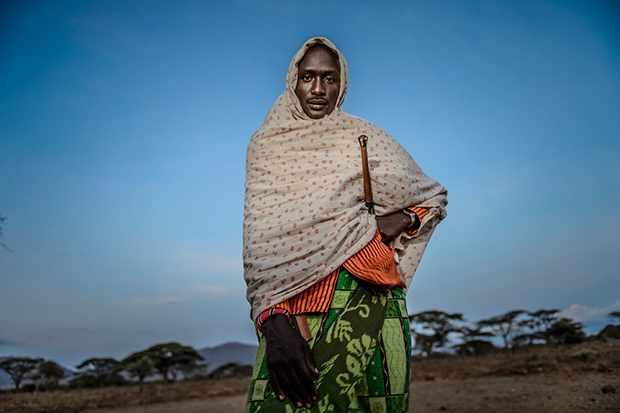Search this site
A National Geographic Photographer Documents Local Communities And their Quest to Combat Illegal Poaching in Kenya

© Ami Vitale
Yusuf, a keeper, sleeps with three orphaned baby rhinos at the Lewa Wildlife Conservancy. The youngest rhino on the right was orphaned when poachers killed his mother on Ol Pejeta Conservancy. The calf was immediately moved to Lewa and is being hand-raised. The largest rhino
Nicky, is not an orphan but is being hand-raised because her mother is partially blind.

© Ami Vitale
Adan, a keeper at Lewa, feeds three orphaned baby rhinos at the Lewa Wildlife Conservancy. The smallest one is Kilifi, middle one is Hope, and the largest is Nicky.
Montana-based photographer and filmmaker Ami Vitale is shedding some much-needed light on the illegal wildlife trade and poaching of animals taking place in northern Kenya. She recently launched a crowdfunding campaign in conjunction with The Nature Conservancy and the Northern Rangelands Trust (NRT), using photography as a platform to show how local communities are working to protect their wildlife from the heavily armed criminal networks of poachers that are devastating to the rhinos, elephants and many other plains animals of Africa. Vitale has traveled to over 85 countries, working with the likes of National Geographic and Time, and has witnessed everything from civil wars to poverty, destruction, and “unspeakable violence.” The people and organizations with whom she has collaborated, however, and “the enduring power of the human spirit” she has experienced throughout have kept her deeply committed to pursuing this type of work and inspired to continue.
She says her project will “focus on the indigenous people of northern Kenya and their efforts to end poaching on ancestral lands by preserving their traditional way of life and strengthening their communities.” While her initial goal has just been reached, she has now turned her sights on to other related and achievable goals, like providing educational, visual storytelling initiatives for the NRT—a collective of 26 indigenous groups in northern Kenya. “Developing the capacity of the people who are instrumental on the ground and closest to the stories can leave a lasting impact. Adding more community engagement and advocacy allows us to get their stories out and heard around the world.”
Vitale’s images illustrate the complex and tense relationship between land, poverty, animals, community, and poachers, but also the symbiosis that can—and will—exist between these same communities with more awareness and effort.
Contribute here until March 5, 2014.

© Ami Vitale
A tusker drinks water at night at the Sarara Conservancy in northern Kenya. This is a unique place in northern Kenya that was once a place of massive tribal infighting. Now communities are using tourism to motivate and persuade local people that there is a future in community-led conservation. These communities now realize that when an elephant is killed, they are losing an asset.

© Ami Vitale
This is a former poacher, Julius Lokinyi, who now works to protect elephants in northern Kenya. By and large, these poachers are desperately poor and they see the enormous amount of money that can be obtained for horns and ivory on the black market. They will risk anything to get it but by giving them alternative livelihoods, it gives them a way out.

© Ami Vitale
A former poacher who now works to protect elephants stands in his village near Archer’s Post, Kenya.

© Ami Vitale
A young herder takes his family’s camel to a well in the difficult and drought stricken region of northern Kenya. Livestock is their most prized and valuable possession; it is the currency here. And when villagers lose livestock, they lose their security.

© Ami Vitale
Women gather to make jewelry to sell to tourists at West Gate Conservancy.

© Ami Vitale
“I am old; I don’t know how old, but I do remember WWII. In the past, we always had to ask our husbands for everything. Today there are more droughts and they have been our biggest problem and have caused much pain and so much insecurity. In the past we would walk for hours in search of water and grazing for our livestock. We used to be forced to migrate during drought and migration, which means our children can’t go to school, we have no access to health care, and we did not have a livelihood like the beading program. NRT has brought water, a school, a health clinic and opportunities for us. The bead program means we can earn for ourselves and it brings more security to the region.”

© Ami Vitale
A Samburu watches a herd of cows in Lewa Wildlife Conservancy in Kenya. Many villagers are turning against poachers because the illegal wildlife trade fuels crime, corruption, instability and intercommunal fighting.

© Ami Vitale
Armed with assault rifles, the 91 response team patrols for poachers on Lewa Wildlife Conservancy. The anti-poaching patrols look and act like an infantry unit. Dog handlers use bloodhounds to track poachers. Lewa protects a 62,000-acre area and supports more than 70 different animal species – including over 10% of Kenya’s population of black rhinoceros and 20% of the world’s population of the endangered Grevy’s zebra.